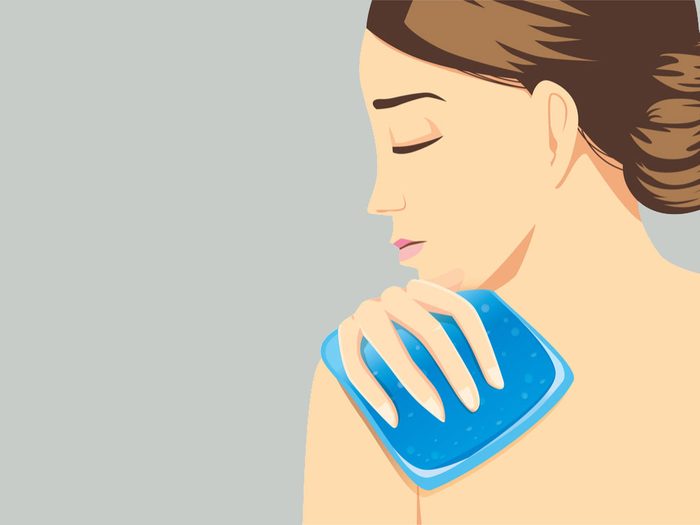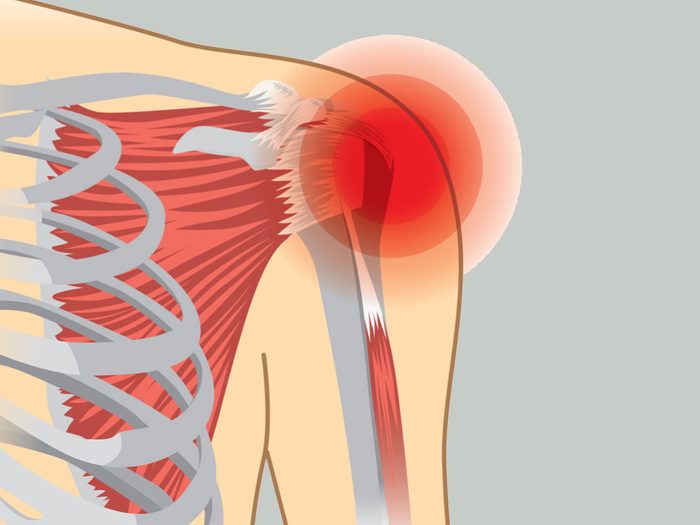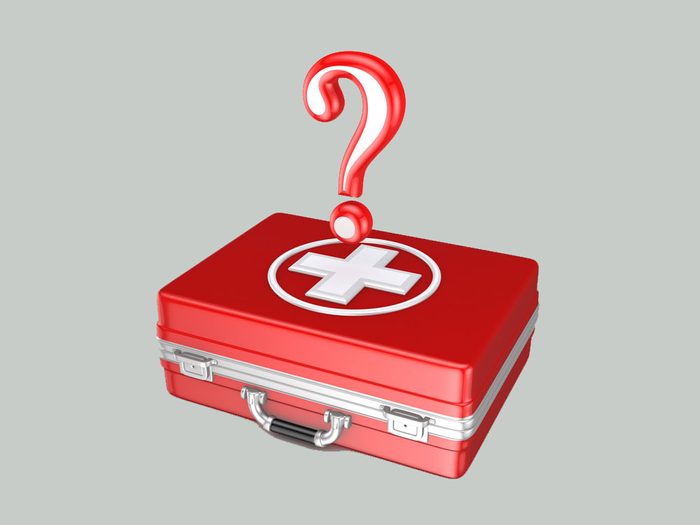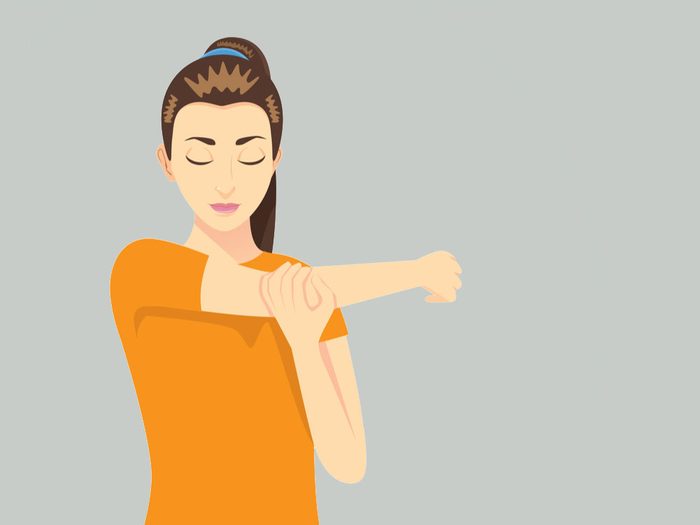
Shoulder pain is not ideal, but knowing exactly what you’re dealing with is key
I had no idea that I was experiencing a frozen shoulder. The first time an electric jolt of pain shot down my right arm from my shoulder, I was reaching behind my back to tuck in my shirt. It felt like a lightning bolt zapping me for 20 seconds.
A few days later, it happened again – this time, I slipped in ski boots and flung my arm up to catch myself. I immediately doubled over from searing pain caused by the sudden movement. At the same time, my range of motion was slowly decreasing. Everyday tasks like styling hair, putting on a fitted shirt and reaching for top-shelf pantry items were becoming more difficult. (And if your back is giving you a hard time, here’s a few natural home remedies to relieve your back pain.)
My shoulder had been acting funny for months – weirdly loose, clicking upon rotation and sore at night if I slept on my right side. I could no longer ignore the fact that something was wrong. X-rays and an ultrasound came back with no sign of obvious injury, yet the pain and stiffening still persisted. Eventually, my family doctor referred me to a sports-medicine specialist, who made a quick diagnosis after testing my range of motion and strength: frozen shoulder.

What is frozen shoulder?
Frozen shoulder (FS), also called adhesive capsulitis, is a condition where the connective tissues surrounding the shoulder joint become inflamed and scar tissue forms inside the capsule, causing extreme pain and stiffness. (Ease joint pain with these foods and supplements.)
It affects between three and five per cent of the population, most commonly women between the ages of 40 and 60, says Dr. Ryan Bicknell, a shoulder and elbow surgeon and an associate professor of orthopaedic surgery and mechanical and materials engineering at Queen’s University in Kingston, ON.
It’s also more common in people with diabetes and hypothyroidism, possibly because those conditions involve abnormalities of the endocrine system, which – among other duties, such as insulin production and hormonal balance – works to regulate inflammation in the body.

Frozen shoulder is a bit of a medical mystery
Like any good story, medical or otherwise, there’s some mystery surrounding the condition when it happens in otherwise-healthy people like me.
In some instances, frozen shoulder is associated with a traumatic injury, such as dislocation or a rotator cuff tear, but in most cases it’s deemed “idiopathic,” meaning that it comes on for no particular reason.
That’s what happened to Jennifer Twyman, too.
“I woke up one morning and a tiny ache started in my shoulder,” says Twyman, a 53-year-old photojournalist and mother of three. “I thought I had just slept on it funny, but then it got worse and worse until I couldn’t even lift my arm.”
I felt the same way about my shoulder – it seemingly came out of nowhere. But the more I thought about it, the more I was certain it was brought on by repetitive strain from our dog – a birder who is prone to erratic lurching (shoulder pulling) if she sees anything with feathers while on a leash.
Leigh Garvie, a sports specialist with the Canadian Physiotherapy Association and a physiotherapist and owner of Coronation Physiotherapy in Edmonton, is also convinced that the condition is triggered by something, even if it’s just an unremarkable accident.
“In practise, I see a lot of people where I think (the frozen shoulder) has come from a trauma, even if it’s a minor trauma,” says Garvie. “It sets off inflammation in the area and then, depending on the injury, the inflammation spreads or the immobility allows it to stiffen up. You don’t want to move your arm because it hurts, and that’s really why it gets stiff: because you stop moving your arm.” (Should you try the anti-inflammation diet to deal with pain?)
The shoulder is unique from other bend-and-extend joints in that it has an extreme range of motion – almost 360 degrees – that makes it more susceptible to injury, says Dr. Bicknell. “The shoulder almost dislocates or partially dislocates with normal range of motion, so it’s a joint that doesn’t stay perfectly concentric in normal day-to-day activities,” says Dr. Bicknell. “Is that part of what can lead to more trauma to that capsule on a daily basis and predispose you to frozen shoulder? Possibly.”

What to do if you have a frozen shoulder
The condition progresses in three stages.
First comes “freezing,” where your range of motion gradually decreases over several months and certain movements – particularly rotation – cause all-consuming pain.
The next phase, “frozen,” lasts between four and six months. This is when the shoulder is stuck, though the pain dwindles to a dull ache, especially at night.
Finally, the shoulder begins “thawing” and movement returns over a six to 24-month period.
Does the recovery period last long?
The timeline from onset to recovery can span two or three years, which is partially what makes it so vexing – that and the pain. “I would reach behind to open the door and the pain would bring me to tears instantly,” recalls Joanne Elves, a 57-year-old freelance writer who recovered from the condition. Elves says that her doctor told her not to worry too much about her shoulder – it’s up to the body when it wants to release. “My doctor was very positive in approaching the problem,” she says. “Cortisone and a nerve block reduced my pain so that my range of motion improved.”
Of course, you can seek help to make the condition more bearable while it runs its course. “Frozen shoulder is one of the most painful conditions we see,” says Dr.Bicknell. He suggests nonsteroidal anti-inflammatory drugs (NSAIDs), such as ibuprofen, to manage the pain. If those are ineffective, he sends patients for a series of cortisone shots in the glenohumeral joint, which helps get the pain under control by reducing inflammation. Once the shoulder no longer hurts, those who are afflicted gradually begin to regain mobility and strength. (Turmeric is also known to have amazing benefits when it comes to relieving inflammation.)
Ways to relieve your pain
Sufferers can also benefit from physiotherapy. Garvie uses both ultrasound and interferential current stimulation (IFC) or high-volt galvanic stimulation to reduce pain by inducing blood flow into the joint. She also manually mobilizes and stretches the capsule to keep the range of motion and assigns stretches for patients to do at home. During the thawing stage, she starts them on a strengthening program to rehabilitate the shoulder’s stabilization muscles, which may have atrophied.
Since adjoining arm and back muscles may become involved as the shoulder stiffens up, therapies like massage, active release, acupuncture and intramuscular stimulation (IMS) can also be beneficial for relaxation and pain management and to maintain mobility. (This may sound too good to be true, but these Under Armour high-tech PJs can help speed up muscle recovery.)
Is there a cure for frozen shoulder?
Unfortunately, no single therapy or treatment is proven to cure or speed up its resolution.
“Some research studies have shown that, no matter what you do, the result is the same two or three years later,” says Bicknell.
The good news: 90 per cent of sufferers can expect to regain full use of their arms and resolve their pain – though there is less success with diabetes and hypothyroidism, adds Dr. Bicknell.
Mine eventually resolved, but it took a full three years. To prevent it from happening again, I’ve taken to walking the dog hands-free by tying the leash around my waist (as far as I know, there’s no such thing as frozen hip).
